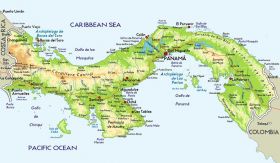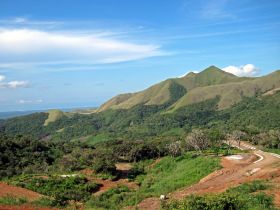In general, what are the different regions or provinces of Panama?
Neil Stein - Panama Paraiso
 Panama is divided into nine provinces:
Panama is divided into nine provinces: Bocas del Toro: Located on the Caribbean, close to Costa Rica
Chiriqui: Located on the Pacific, close to Costa Rica
Cocle': Southwest of Panama City
Colon: North of Panama City on the Atlantic
Darien: Huge province east of Panama City - runs all the way to Colombia between both oceans
Herrera: Capital...
 Panama is divided into nine provinces:
Panama is divided into nine provinces: Bocas del Toro: Located on the Caribbean, close to Costa Rica
Chiriqui: Located on the Pacific, close to Costa Rica
Cocle': Southwest of Panama City
Colon: North of Panama City on the Atlantic
Darien: Huge province east of Panama City - runs all the way to Colombia between both oceans
Herrera: Capital city is Chitre'
Los Santos: On the Azuera Peninsula
Panama: Includes Panama City
Veraguas: Capital city is Santiago
 There are also three Indigenous Regions in Panama more commonly known as Comarcas:
There are also three Indigenous Regions in Panama more commonly known as Comarcas: - Embera
- Kuna Yala
- Ngobe-Bugle'
All of these regions are unique unto themselves and have a tremendous amount to offer!
Posted April 15, 2013
Lourdes Townshend
Panama has 9 provinces and 2 districts. In the districts local natives enjoy privileges, and live daily with customary clothes, meals and traditions. They make beautiful crafts, for example, the molas, which are recognized as one of the most beautiful pieces of craft in the world. In Darien, they make the "taguas", from tree roots,which are beautiful and unique as well. Each piece of these crafts are handmade, and unique in...
Panama has 9 provinces and 2 districts. In the districts local natives enjoy privileges, and live daily with customary clothes, meals and traditions. They make beautiful crafts, for example, the molas, which are recognized as one of the most beautiful pieces of craft in the world. In Darien, they make the "taguas", from tree roots,which are beautiful and unique as well. Each piece of these crafts are handmade, and unique in the world.
One of the most visited tours in Panama City is the "Emberá Tour Aventure", in which you visit their village by boat, have lunch with them and enjoy their people and crafts. Usually natives use their customary clothes every day, which are very picturesque.
The 9 provinces are connected east and west by a modern highway named the "Interamericana" that goes through several towns and small cities, and gives the traveler the opportunity to enjoy different Panamanian housing styles, the smell of the country, all kinds of small animals, cattle, beautiful flowers and old trees, by which Panamá is famous. As a matter of fact, Panama means: "abundance of fish and trees". This is all not to mention the famous "empanadas", "carimañolas" and "bollos", which are Panama's favorite snacks, that you can get along the highway.
In all these extensive regions (called the "interior"), you can enjoy mountains, beaches, modern resorts, hospitals, malls with the latest fashions, international airports, residential areas, as well as law enforcement agencies and regional government buildings. The central part of the country is mainly the Panamanian folkloric historical place.
In January they have the most beautiful parade called "The 100 Polleras". (The "pollera" is the national Panamanian dress). Also in January you can enjoy in Boquete the "Feria de las Flores", where you can admire hundreds of the most beautiful and exotic flowers and plants. There is still some infrastructure needed, though, in the interior, to accommodate the booming tourism.
Also you can go to the Caribbean side of Panama, from south to north from Panama City, to the second major city, Colon. Colon has one of the major ports in the world: Cristóbal, and the Panama Free Zone. You can enjoy a 1.5 hours train ride along the Panama Canal, which departs at 7 AM and returns at 5 PM. Very interesting.
Their coast is very beautiful, and goes all the way to the famous and beautiful "San Blas Islands". There are several resorts being built in this area, especially in the area of Portobelo (with a history back to the 15th century), that is not yet developed as other regions. In this area, you can go to Isla Grande. One of the most recognized events in this area is the "congo festival", a very interesting and historical dance.
Don´t miss the complete article regarding ethnic groups in Panamá.
Posted September 21, 2013


